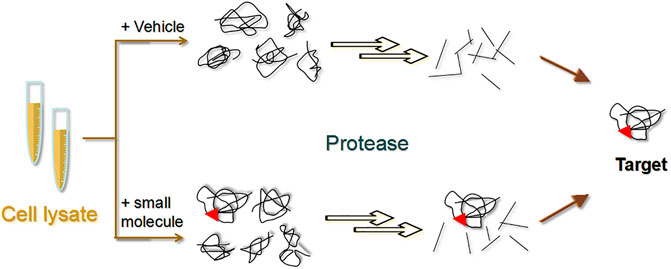Introduction of Drug Affinity Responsive Target Stability (DARTS)
Drug target protein identification is an important step in the research and development of new drugs. Drug Affinity Response Target Stability (DARTS) is a technique that can rapidly and directly identify potential target proteins of small molecule drugs. That is, it prevents the target protein from being hydrolyzed by proteases after binding to the drug, thus maintaining the activity and function of the target protein.
Workflow of DARTS
Drug affifinity responsive target stability (DARTS) assay contains a few steps. First, the purifified protein or cell lysate is mixed with the small molecule of interest. The solvent molecule or the inactive analog molecule will be mixed with the protein as well as necessary controls for the DARTS assay. Then, incubate the mixture of the protein and the small molecule with gentle shaking. The mixture is then aliquoted into small volumes, and the same volume of different concentrations of protease is added to the aliquots of the mixture. After a certain time of protease digestion, stop the digestion reaction by deactivating the protease. The next step is to separate the protease-digested samples on SDS-PAGE and use different approaches to detect the candidate target protein. The protection of protein degradation can be quantifified by comparing the abundance of candidate protein in samples incubated with an active molecule with that of solvent or inactive analog control molecules. If the ligand molecule binds to the candidate protein, higher protein abundance is expected in the sample mixed with the ligand molecule[2].

The drug affinity responsive target stability strategy[1]
Advantages of DARTS
The ligand does not need to be modifified so the native ligand could be used.
The candidate target protein could be either purifified protein or protein that is present in the total cell lysate.
The assay can be used together with proteomics analysis to identify an unknown target protein. The assay is especially valuable to test the interaction between the ligand and membrane proteins that are often challenging to purify.
Advances in the Application of DARTS Technology
1. Target identification of piperazine-like small molecule RX-5902
Kost et al. used DARTS technology and isotope labeling to demonstrate that the piperazine-like small molecule RX-5902 can inhibit the growth of cancer cells by binding to phosphorylated p68RNA helicase and down-regulating the expression of c-Myc, cyclin Dl and p-c-Jun genes in the β-chondin signaling pathway, thus revealing the molecular mechanism of its anticancer effect.
2. Identification of dichloroacetate as a target for LoVo cell growth inhibition
Dichloroacetate (DCA), an inhibitor of pyruvate dehydrogenase, has recently been found to be a non-toxic antitumor agent, but its specific mechanism is not clear. Gong et al. also demonstrated that DCA can lead to abnormal aggregation of reactive oxygen species (ROS) through histone D (CTSD) and thioredoxin-like protein 1 (TXNL1), and that Akt-mTOR, the most important negative regulatory pathway for autophagy, is inhibited.
3. Identification of the anti-HIV targets of ratjadone A
Fleta-Soriano et al. found that Ratjadone A, a mucilaginous metabolite, inhibits human immunodeficiency virus HIV infection in vitro and analyzed its target by DARTS technique. The results showed that ratjadone A inhibited the formation of CRM1-Rev-NES complex by binding to CRM1/Exportinl, which interfered with the recognition of the leucine-rich region signal in the Rev protein by the host protein CRM1/Exportinl, thus inhibiting the nuclear export of the non-spliced or partially spliced mRNA genome of HIV.
4. Molecular mechanisms of α-ketoglutarate mediated longevity
α-ketoglutarate (α-KG) is an important metabolic intermediate in the tricarboxylic acid cycle. Chin et al19 found that α-KG prolongs the lifespan of nematodes. The results of DARTS experiments showed that the target of α-KG is the β-subunit of ATP synthase. The binding of α-KG to the ATPase subunit decreased its ATP synthesis capacity, reduced oxygen consumption, and increased autophagy in nematode and mammalian cells in the experiment, revealing a mechanism by which α-KG, a key metabolite, mediates longevity.
5. Targeting of triple negative breast cancer cells by disulfiram
Triple negative breast cancer (TNBC) refers to breast cancer that is negative for estrogen receptor (ER), progesterone receptor (PR) and human epidermal growth factor receptor 2 (Her-2), which can only be treated clinically with radiotherapy and chemotherapy. Robinson et al. used a high-throughput screening method to screen out disulfiram (DSF) from 3185 compounds to inhibit the growth of a variety of TNBC cells. The results of the DARTS assay revealed that direct targets are GTPase activating protein 1 (IQ motif containing GTPase activating protein 1, IQGAP1) and myosin heavy chain 9 (MYH9).
6. Mechanism of grape seedextract to inhibit the proliferation of rectal cancer cells
Grape seedextract (GSE) has a variety of biological activities. Using human rectal cancer cells (CRC), Derry et al. applied DARTS technique with LC/MS and MASCOT data analysis methods to demonstrate that GSE can lead to an overall downregulation of translation-related proteins and strongly inhibit the PI3k-Akt-mTOR signaling pathway.
Summary
The discovery of drug targets requires not only the use of different instruments but also the continuous updating of methodologies, and the discovery of DARTS as a new technique for target screening is of great importance and has a strong application in drug research. Future research will integrate proteomics, protein degradomics, reaction condition studies, new drug screening, etc., and there will be a large number of scientific achievements.
References
- Brett Lomenick, et al. Target identification using drug affinity responsive target stability (DARTS) Authors Info & Affiliations December 22, 2009 106 (51) 21984-21989
- Huang L., Wang D., Zhang C. (2021) Drug Affinity Responsive Target Stability (DARTS) Assay to Detect Interaction Between a Purified Protein and a Small Molecule. In: Hicks G.R., Zhang C. (eds) Plant Chemical Genomics. Methods in Molecular Biology, vol 2213.







